RAID Levels (0 to 6) – with Use-Cases
RAID (Redundant Array of Independent Disks) is a data storage technology that combines multiple physical disk drives into one logical unit. The primary goals of RAID are to improve performance, ensure data redundancy, or achieve a balance of both. Each RAID level offers a different combination of speed, fault tolerance, and storage efficiency.
RAID is widely used in servers, cloud infrastructure, and enterprise systems where data availability and reliability are critical.
RAID 0 – Striping (No Redundancy)
RAID 0 splits (stripes) data across two or more disks, allowing simultaneous read/write operations.
- Advantage: Extremely fast read/write performance.
- Disadvantage: No data redundancy; if one disk fails, all data is lost.
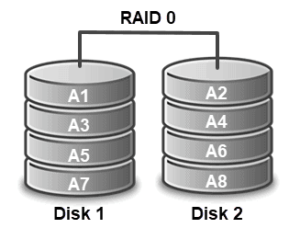
Use Case: Ideal for applications needing high speed and no critical data protection, such as video editing, gaming systems, or temporary storage.
RAID 1 – Mirroring
RAID 1 stores an exact copy (mirror) of data on two or more disks.
- Advantage: High fault tolerance. If one disk fails, the system continues operating with the mirrored disk.
- Disadvantage: Requires double the storage capacity (50% efficiency).
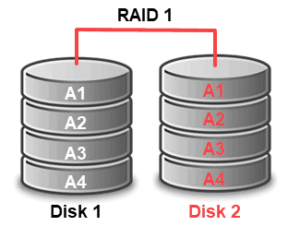
Use Case: Best suited for systems that prioritize data reliability over storage capacity, such as accounting systems, database servers, and boot drives.
RAID 2 – Bit-Level Striping with Hamming Code
RAID 2 uses bit-level striping across multiple disks and includes dedicated disks for error correction using Hamming Code.
- Advantage: Can correct single-bit errors.
- Disadvantage: Complex and not used in modern systems due to better alternatives.
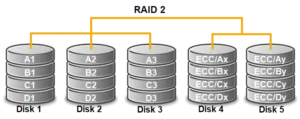
Use Case: Rarely used today; primarily a historical design with no real-world implementation in current systems.
RAID 3 – Byte-Level Striping with Dedicated Parity
RAID 3 stripes data at the byte level across multiple disks and uses a single dedicated disk for storing parity (error-checking information).
- Advantage: Provides good throughput for large sequential data.
- Disadvantage: The dedicated parity disk can become a bottleneck under heavy I/O.
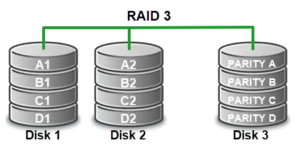
Use Case: Suitable for systems dealing with large file transfers, such as video streaming or imaging applications.
RAID 4 – Block-Level Striping with Dedicated Parity
RAID 4 improves on RAID 3 by striping data at the block level, allowing multiple independent read operations. However, it still relies on a dedicated parity disk.
- Advantage: Faster than RAID 3 for read operations.
- Disadvantage: Write performance suffers due to parity bottleneck.
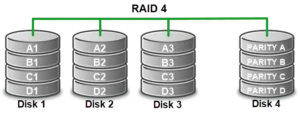
Use Case: Useful in systems with high read demands but less frequent writes, like document archives or backup servers.
RAID 5 – Block-Level Striping with Distributed Parity
RAID 5 stripes both data and parity across all disks in the array. This eliminates the single parity disk bottleneck.
- Advantage: Balanced performance and fault tolerance. Can survive the failure of one disk.
- Disadvantage: Slower writes due to parity calculations; rebuild time after disk failure can be long.
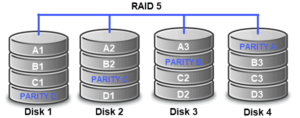
Use Case: Common in file servers, web servers, and database systems where performance and data integrity are both important.
RAID 6 – Block-Level Striping with Double Distributed Parity
RAID 6 builds on RAID 5 by adding an extra layer of parity, allowing it to tolerate failure of two disks simultaneously.
- Advantage: Higher fault tolerance than RAID 5.
- Disadvantage: Slower writes and more storage overhead due to dual parity.
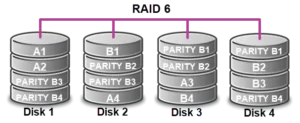
Use Case: Preferred in mission-critical systems where uptime and data protection are essential, such as cloud services, enterprise databases, or financial systems.